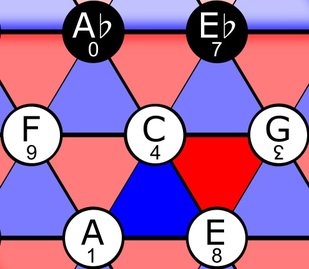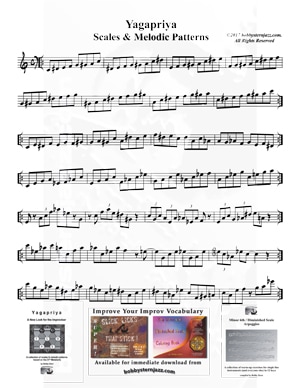The Tale of Yagapriya and the Tonnetz
 Yagapriya and the Tonnetz
Yagapriya and the Tonnetz Yagapriya is the 31st raga, out of a total of 72, in the Carnatic (South Indian) Melakarta system of seven-note parent ragas, from which other smaller ragas are derived.
Besides its Carnatic origin, this post was inspired as much by my belated introduction to the Neo-Riemannian “Tonnetz” (German for “tone network” and pronounced "tone netz"), which clearly illustrates Yagapriya's internal intervallic and chordal relationships.
I had never heard of the Tonnetz before receiving an email recently from Uruguayan mathematics researcher and amateur guitarist Alfonso Artigue, who's interest in both disciplines lead him to the discovery of the relationship between the Tonnetz and the Yagapriya raga. He had found an earlier post I had done on the scale and contacted me about his discovery. I Thank you, Alfonso!. Yagapriya thanks you, too.
Each horizontal line, from left to right, is in perfect 5ths (Ab - Eb, F - C - G, A - E).
The diagonal from top left to bottom right is in Maj 3rds (Ab augmented triad).
The diagonal from top right to bottom left is in min 3rds (A diminished triad).
Each triangle within the hexagon forms a Major or minor triad.
F min., Ab Maj., C min., F Maj., A min., C Maj
These triads can be expanded into four note 6th and 7th chord configurations as well.
F Maj7 (9), F min7 (9), F7 (9), F min(Maj)7 (9), A min7 (C6), A min(Maj)7, A min7b5 (C-6), Ab Maj7, Ab Maj7+5, Ab6, E Maj7+5,
The C in the middle of the hexagon is common to each triad / 7th chord and is, not coincidentally, also the root of the scale formed as “C" Yagapriya :
C – Eb – E - F – G - Ab – A - C
Yagapriya's uniqueness also stems from its scalar interval scheme,
1 ½ steps – ½ step – ½ step – whole step – ½ step – ½ step – 1 ½ steps
(C Eb E F --- G Ab A C)
with the two tetrachords being an intervallic mirror image of each other; a scalar palindrome of sorts.
Prominent derived pentatonics include: C Pentatonic #2 (C-Eb-E-G-A), Ab Pentatonic b2 (Ab-A-C-Eb-F) & F Pentatonic b7 (F-G-A-C-Eb).
It contains four perfect 4ths and one tritone (Eb – A), which doesn't serve as a function of diatonic resolution (V - I) as it would in the Major scale system. However, a type of ersatz V7 – I movement can be established since the scale itself yields a V7sus b9 9 b13 13 (G-C-F-Ab-A-Eb-E) configuration.
Both the diatonic triadic and seventh chord harmonizations of Yagapriya in the examples below, as well as the arpeggio exercises found in "Yagapriya - A New Look for the Improviser", were conceived with smooth melodic and harmonic movement in mind. In fact, the original concept behind the Tonnetz, nearly three hundred years ago, was as a visual aid for detecting common tones between triads, which results in smooth voice leading.
The seventh chord arpeggio exercise (see download, chords above) which harmonizes each scale step, alternates a tonic Maj6 (C6 in C) chord with the Maj6 (Ab6) chord built on the sixth scale degree - or interchangeably, its inversion, a min7 (F-7), from the fourth scale degree. The exception here is the seventh degree, which employs a half diminished chord (A-7b5). In other words, as C is constant throughout, the notes A-E and G swap inversions with F-Ab and Eb (except for the half diminished chord).
The melodic patterns here were conceived as non Carnatic in nature. Instead, they focus, for the most part, on a more familiar blues oriented coloration, due to the presence of both Major and minor 3rds & 6ths.
Once it becomes familiar, this can be a very natural, earthy sounding scale. The absence of a b7 or #4 doesn't prevent Yagapriya from being one funkified pitch collection!
One suggestion would be to play the scale, exercises, patterns, etc. against a drone of different scale tones, know in Carnatic terms as "graha bhedam".
Interesting results are sure to abound!





 RSS Feed
RSS Feed









